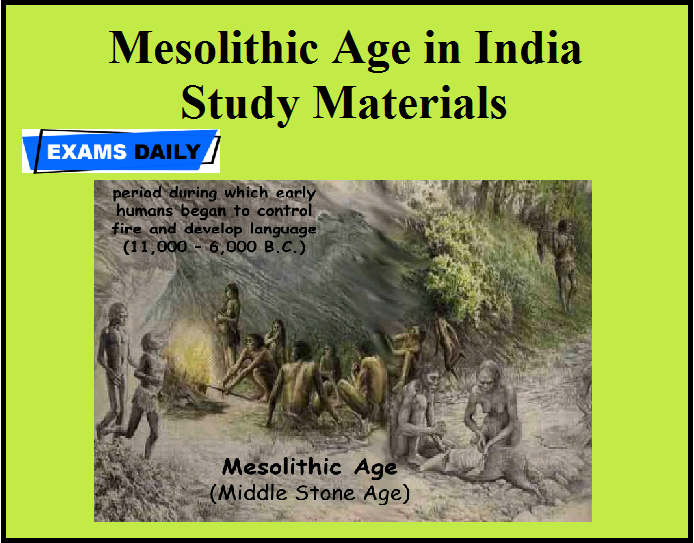Mesolithic Age in India Study Materials
THE MESOLITHIC MAN (APPROXIMATELY 8000-4000 BC)
The biggest sign of the transformation of the Palaeolithic Age to the Mesolithic Age was the use of animal bones in the place of stones. The Mesolithic man began making use of special weapons, known as ‘micro lithic’ or ‘pygmy tools’. These tools were made from jasper chalk or blood stone. He was still unaware of the use of fire and did not practice agriculture. However, he had made the dog his pet and also had begun using wooden handles for tools and weapons. The art of making pot of clay is also an important development of the Mesolithic Age. Man still led a nomadic life. However, he started the practice of burying the dead.
The microliths, themselves insignificant, present a great technological development—the introduction of compound tools. The tools were universally” very small, sometimes barely an inch or half an inch long, and so could not be used otherwise. Economically, man was still savage, a hunter- fisher, a change was indicated in man’s modus operandi by his toolkit and the materialsof which it was made. However, in some areas as elsewhere in the world, there appeared the next great step—pottery making—with its concomitant of permanent habitation and food production.
Download Prehistoric Period of India Study Materials PDF
Pre-history: Important Terms
Pre-history: If is the period for which we do not have any written records.
Proto-history: This is the period for which we have written records, but we are still unable to decipher the script.
Historic period: This is the period for which we have written records in the form of inscriptions and other texts.
Palaeography: It is the study of old writings used in inscriptions and other ancient records.
Download Ancient History Study Materials PDF
Megalithic Burial Type
In eastern India, microliths are generally found on the surface of laterite plains and in the forests in Orissa, Bengal and Chota Nagpur Plateau and on the rocky (sandstone) hillocks of Mirzapur. The few small scale excavations in these regions indicate their probable antiquity and the prevailing climatic conditions. Typologically, the microliths are non-geometric, that is, such forms as the triangle and trapeze were absent. The tools were generally made of milky quartz, though crystal, chert, chalcedony, quartzite and fossil wood of which large chunks have been found. Excavations at Birbanpur near Durgapur railway station on the bank of the Damodar River in Burdwan district (West Bengal) showed early microliths. The Kashmir Range, at the junction of Madhya Pradesh and Uttar Pradesh and small-scale excavations of open air sites and rock shelters at Morahana Pahar and Bhaghaikhor near Bhainsaur and Lekhania (near Mirzapur), yielded the first non-geometric microliths and later the geometric ones with an ill-baked ochre-red pottery. The later microliths include bladers (retouched and simple), lemates, trapezes, triangular pieces, scrapers, points and a few burins. The occurrence of one ring stone or mace head of quartzite among heavy tools and two small ground or polished tools of chlorite schist at Langhnaj and Akhaj sites, in sandy alluvial plains of northern and central Gujarat, seem to be significant implying contact with or a knowledge of such tool making centres. Such tools suggest that either man had begun to cultivate with the help of a digging stick for which quartzite ring was used as a weight or the ring was used as a mace head- a powerful offensive weapon. Pottery, though extremely few and ill baked, is associated with later microliths, which further suggests that during this period, at least temporary camps or habitations were formed.
Later, people buried the death in large, stone-lined pits and covered them with still large slabs, sometimes only one and deserve the name ‘Megalithic’, occupied the area. The dead were buried in highly crouched postures, preferably in north-south direction, very much like the characteristics of the Mediterranean and the Vedic racial groups. The presence of rhinoceros implies that the environment provided by lakes and the surrounding areas of scrub forests was congenial enough for such animals to flourish or that the rhinoceros lived on river banks, where they were hunted by man and their carcasses brought up to the mound. Fishing also provided food as the pieces of carapace of tortoise and fish vertebrae were found. The age of this culture is not yet determined. The Teris of South India, Birbanpur and pre-pottery and non-geometric levels in Mirzapur in eastern India represent early phases of this Age. The later phases at Mirzapur and other sites in Uttar Pradesh, Madhya Pradesh and Langhnaj in northern Gujarat, where pottery occurs without any definite evidence of domestication of animals and incipient agriculture might represent the next stage.
Download Mesolithic Age in India PDF
Download Full History Study Materials
Whatsapp ![]() Group Click Here
Group Click Here
Telegram ![]() Channel Click Here
Channel Click Here
Join Us on ![]() FB : English – Examsdaily
FB : English – Examsdaily ![]() Twitter – Examsdaily
Twitter – Examsdaily

